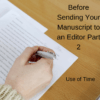
Before Sending Your Manuscript To An Editor / Part 2: Use of Time
Note from the Editor: This second installment of Before Sending a Manuscript to an Editor series offers basic editing tips around time use of time. For Part 1: Self-Editing Techniques Click here. For Part 3: Time Sequencing and Flashbacks Click here
Clean Up Your Use of Time
This second post on self-editing revolves around the use of time. In the next post, I will write about time sequencing and flashbacks.
1. The historical present looks like the past, but it isn’t.
What tense are you going to use to narrate your story?
[Free Membership required to read more. See below. ]
We'd love to have you access this content. It's in our members-only area, but you're in luck: becoming a member is easy and it's free.
Already a Member?
Not a Member Yet?

Historical Present: A Better Relationship to Memoir Story Time
Your relationship to memoir story time
Writers often jumble the use of time in the memoir. The time in which the story unfolds is considered to be the present of the story—often called the “historical present.”
When I write, “She ran into the woods,” the run occurs in the present of the narration—that is the memoir story time. While I have used the past tense (ran), the reader sees the woman running in the mind’s present. We call that the “historical present.”
The reader is always mentally in the present of the story. Following is a line from a text I edited recently. The present of the text is in the spring of the year while the move mentioned in the story was sometime in the past of the story present. That is, it occurred some time previous to what we consider the story present [the historical present].
This is the line the editing client had written, “…a couple of months after I moved into my new apartment…” [Free Membership required to read more. See below. ]
